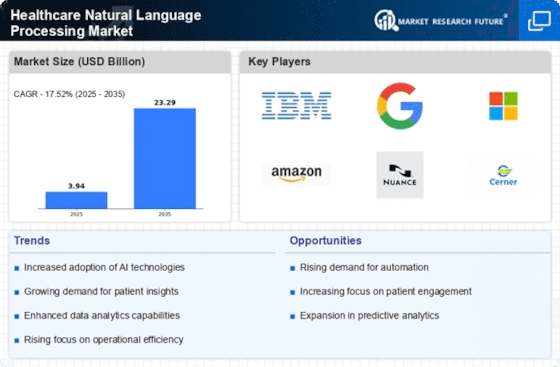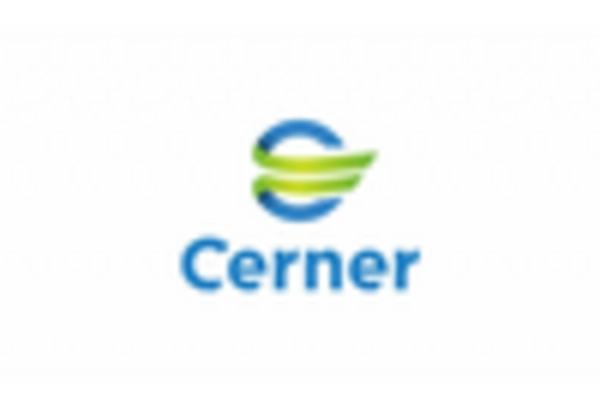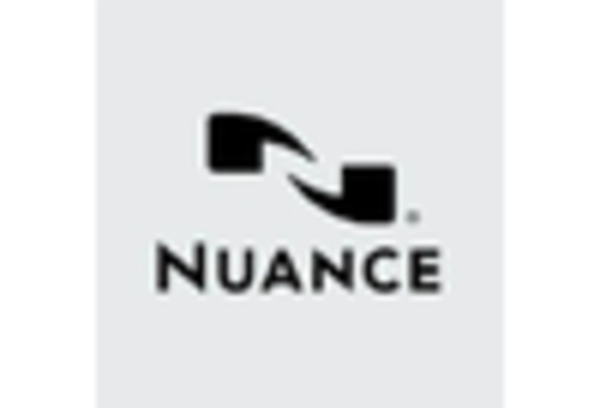Rising Demand for Data-Driven Insights
The Healthcare Natural Language Processing Market is experiencing a notable surge in demand for data-driven insights. Healthcare providers are increasingly recognizing the value of extracting actionable information from unstructured data sources, such as clinical notes and patient records. This trend is driven by the need for improved patient outcomes and operational efficiency. According to recent estimates, the market for healthcare analytics is projected to reach USD 50 billion by 2026, indicating a robust growth trajectory. As organizations seek to leverage data for decision-making, the integration of natural language processing technologies becomes essential. These technologies facilitate the analysis of vast amounts of textual data, enabling healthcare professionals to derive insights that can enhance patient care and streamline administrative processes.
Increased Focus on Telehealth Solutions
The Healthcare Natural Language Processing Market is witnessing an increased focus on telehealth solutions, which have become integral to modern healthcare delivery. As telehealth services expand, the need for effective communication tools that can process and analyze patient interactions becomes paramount. NLP technologies play a crucial role in enhancing telehealth platforms by enabling real-time transcription, sentiment analysis, and automated follow-up communications. This shift towards telehealth is supported by a growing body of evidence suggesting that remote consultations can lead to improved patient satisfaction and adherence to treatment plans. The telehealth market is projected to reach USD 459 billion by 2030, indicating a substantial opportunity for NLP applications to enhance service delivery and patient engagement.
Growing Emphasis on Regulatory Compliance
The Healthcare Natural Language Processing Market is increasingly shaped by the growing emphasis on regulatory compliance. Healthcare organizations are under pressure to adhere to stringent regulations regarding patient data privacy and security, such as HIPAA in the United States. NLP technologies can assist in ensuring compliance by automating the monitoring of communications and documentation for adherence to regulatory standards. This capability not only mitigates the risk of non-compliance but also enhances the overall quality of care provided to patients. As regulatory frameworks continue to evolve, the demand for NLP solutions that can support compliance efforts is expected to rise. The market for compliance management solutions in healthcare is projected to grow significantly, reflecting the critical role of NLP in navigating complex regulatory landscapes.
Advancements in Machine Learning Algorithms
The Healthcare Natural Language Processing Market is significantly influenced by advancements in machine learning algorithms. These innovations enhance the ability of NLP systems to understand and interpret complex medical language, thereby improving the accuracy of clinical documentation and patient interactions. Recent developments in deep learning techniques have shown promise in processing large datasets, which is crucial for the healthcare sector. As machine learning continues to evolve, it is expected that the efficiency of NLP applications will improve, leading to better patient outcomes and reduced operational costs. The market for machine learning in healthcare is anticipated to grow at a compound annual growth rate of over 40% in the coming years, underscoring the potential impact of these technologies on the healthcare landscape.
Integration of NLP in Electronic Health Records
The Healthcare Natural Language Processing Market is experiencing a transformative shift with the integration of NLP technologies into electronic health records (EHRs). This integration allows for the extraction of meaningful insights from unstructured data within EHRs, facilitating better clinical decision-making and patient management. As healthcare providers seek to enhance the usability of EHR systems, NLP applications are becoming essential tools for improving data accessibility and interpretation. The EHR market is expected to reach USD 40 billion by 2026, highlighting the potential for NLP to drive innovation in this space. By enabling more efficient data entry and retrieval processes, NLP can significantly reduce administrative burdens on healthcare professionals, ultimately leading to improved patient care.

















Leave a Comment